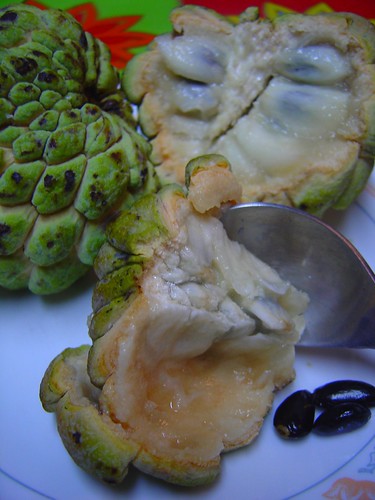
Our client was visiting our office and we started talking about local fruits that she has tried at the hotel where she is staying. She loves the local mangoes and the mangosteens. Later in the conversation she was describing a fruit that was red and had spiky hairs. The fruit was white with a large seed. I told her that was a rambutan, similar to lychees but the sweetness is entirely different.
I asked her if the hotel also served a locally grown fruit called atis. In other countries this fruit is called sugar apple or sweetsop. Relative to the custard apple since it belongs to the same Annona family, the meat is sweet having a 50-50 ratio of sucrose and glucose. I showed her a photo of the fruit, and she said they didn't serve this in the hotel. So I brought one the following day. She was amazed and surprised with the sweetness and the number of seeds a fruit could have. She still prefers the rambutan though and couldn't get enough of it.
In my research for this entry, I found out interesting facts about this delectable fruit:
- for every 100g of edible meat, there is 88.9 - 95.7g of calories; 40mg of vitamin C and is a good source of iron.
- the meat may be eaten raw, turned into ice-cream, cider or wine
- there are medicinal properties that may alleviate rheumatic pain, dizziness and fainting spells; treat dysentery, colds and fever. However the seeds are said to be poisonous and may cause blindness despite it's healing remedy for hair lice.
- the blacken aborted fruit is part of the ingredients for "unton" ( a pillow pouch pinned to a child's dress to fight against bales or "bati")
From experience, when buying, pick the firm and harder fruit. The size of the "scales" should have defined groves. It is fine to get the pieces with dark firm spots at the top. Place the fruit in a sturdy container, the firmest on on the bottom and the least on top. When it is ripe, the fruit becomes verify delicate and is easily bruised. In storing, keep in room temperature until it is soft. To prolong it's shelf life, store the fruit in the refrigerator when it is almost ripe but not overly so.
References:
http://www.philippineherbalmedicine.org/atis.htm
http://en.wikipedia.org/wiki/Sugar-apple
http://www.stuartxchange.org/Atis.html
http://www.hort.purdue.edu/newcrop/morton/sugar_apple.html
2 comments:
I have not eaten a custard for ages. It's a great fruit.
Yes it definitely is. Whenever my aunt would come to the city and it is atis season, she would bring some and I end up eating a lot.
Post a Comment